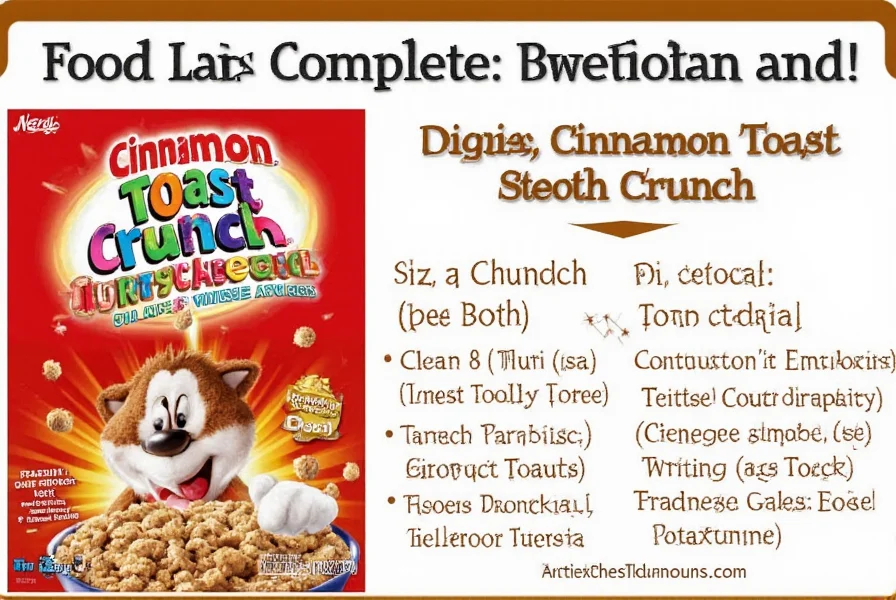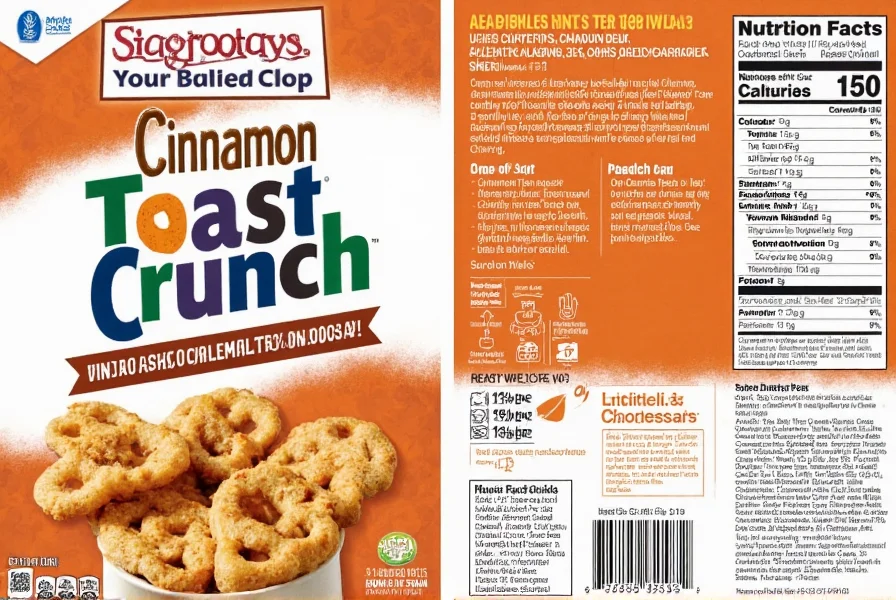Understanding food labels is essential for making informed dietary choices, especially for popular breakfast cereals like Cinnamon Toast Crunch. This comprehensive analysis breaks down exactly what appears on Cinnamon Toast Crunch packaging, helping consumers understand the nutritional profile, ingredient composition, and potential dietary considerations.
Nutritional Profile Breakdown
When examining the Cinnamon Toast Crunch food label, several key nutritional elements stand out. A standard serving (3/4 cup or 55g) provides:
| Nutrient | Amount per Serving | % Daily Value* |
|---|---|---|
| Calories | 190 | |
| Total Fat | 5g | 6% |
| Saturated Fat | 0.5g | 3% |
| Trans Fat | 0g | |
| Cholesterol | 0mg | 0% |
| Sodium | 230mg | 10% |
| Total Carbohydrate | 34g | 12% |
| Dietary Fiber | 2g | 7% |
| Total Sugars | 10g | |
| Included Added Sugars | 9g | 18% |
| Protein | 2g |
*Percent Daily Values are based on a 2,000 calorie diet. Your daily values may be higher or lower depending on your calorie needs.
Ingredient Analysis: What's Really in Cinnamon Toast Crunch
The Cinnamon Toast Crunch ingredients list reveals more than just the basic nutrition facts. The full ingredient statement typically reads:
Whole Grain Wheat, Sugar, Rice Flour, Canola and/or Sunflower Oil, Fructose, Trisodium Phosphate, Salt, Cinnamon, Soy Lecithin, BHT for freshness, Natural Flavor, Vitamin E (mixed tocopherols), Niacinamide, Reduced Iron, Zinc Oxide, Pyridoxine Hydrochloride (Vitamin B6), Riboflavin (Vitamin B2), Thiamin Mononitrate (Vitamin B1).
Let's break down some key components that appear on the Cinnamon Toast Crunch food label:
- Whole Grain Wheat: The primary ingredient, providing carbohydrates and some fiber
- Sugar: The second ingredient, indicating significant sugar content
- Rice Flour: Used to create the signature "crunch" texture
- Canola and/or Sunflower Oil: Used for texture and to help distribute cinnamon flavor
- Trisodium Phosphate: A common food additive used as an acidity regulator
- Natural Flavor: Contains the cinnamon flavoring (despite "cinnamon" also being listed separately)

Allergen Information and Dietary Considerations
For those with food sensitivities, the Cinnamon Toast Crunch food label contains important allergen information. The product:
- Contains wheat (a common allergen and source of gluten)
- Contains soy (in the form of soy lecithin)
- Is not gluten-free due to the wheat content
- Is not suitable for individuals with celiac disease
- Does not contain dairy ingredients, making it suitable for lactose-intolerant individuals
- Is not certified vegan due to potential processing methods, though ingredients appear plant-based
Understanding Label Terminology
Many consumers wonder about specific terms on the Cinnamon Toast Crunch food label:
"Natural Flavor" - This term often causes confusion. In Cinnamon Toast Crunch, the natural flavor primarily refers to the cinnamon flavoring system. While "cinnamon" appears separately in the ingredients, the "natural flavor" contains additional compounds that enhance and stabilize the cinnamon taste.
"Trisodium Phosphate" - This food additive serves multiple purposes in cereal production. It acts as a dough conditioner in the manufacturing process, helps maintain the cereal's structure during shipping, and contributes to the distinctive texture that makes Cinnamon Toast Crunch "crunch" when milk is added.
"BHT for freshness" - Butylated hydroxytoluene is a preservative that prevents the oils in the cereal from becoming rancid. While some consumers prefer to avoid this ingredient, it's approved by the FDA as safe for consumption in the small amounts used in food products.
Comparing Cinnamon Toast Crunch to Similar Products
Understanding how Cinnamon Toast Crunch compares to similar cereals provides valuable context for interpreting its food label:
| Cereal Product | Sugar per Serving | Fiber per Serving | Protein per Serving | Gluten-Free |
|---|---|---|---|---|
| Cinnamon Toast Crunch | 10g | 2g | 2g | No |
| Honey Nut Cheerios | 9g | 3g | 3g | Yes (certified) |
| Frosted Flakes | 12g | 1g | 2g | No |
| Cinnamon Grahams | 9g | 3g | 2g | No |
This comparison of Cinnamon Toast Crunch nutrition facts against similar products shows that while its sugar content is typical for sweetened breakfast cereals, it has relatively low fiber and protein content compared to some alternatives.
Practical Tips for Interpreting Cinnamon Toast Crunch Food Labels
When reading Cinnamon Toast Crunch food labels, consider these practical insights:
- Serving size matters - the 3/4 cup measurement is smaller than many people pour
- Actual sugar consumption may be higher if eating multiple servings
- Check for regional variations - ingredients may differ slightly between US and international versions
- Look for fortified vitamins and minerals, which add nutritional value
- Be aware that "whole grain" doesn't automatically mean high fiber
Health Considerations and Balanced Consumption
While Cinnamon Toast Crunch can be part of a balanced diet, understanding its food label helps make informed choices. The relatively high sugar content (10g per serving, with 9g being added sugar) means it's best consumed in moderation, particularly for children.
Nutrition experts often recommend pairing Cinnamon Toast Crunch with additional protein sources like milk or yogurt to create a more balanced breakfast. The 2g of fiber per serving is modest, so adding fruit can boost the fiber content and provide additional vitamins.
For those monitoring sugar intake, being aware of the Cinnamon Toast Crunch ingredients list helps understand where the sweetness comes from and make appropriate consumption decisions.
Frequently Asked Questions
How much sugar is actually in Cinnamon Toast Crunch according to the food label?
According to the official Cinnamon Toast Crunch food label, each 3/4 cup (55g) serving contains 10 grams of total sugar, with 9 grams being added sugars. This represents approximately 18% of the recommended daily limit for added sugars based on a 2,000 calorie diet.
Is Cinnamon Toast Crunch gluten-free based on its food label information?
No, Cinnamon Toast Crunch is not gluten-free. The food label clearly lists whole grain wheat as the first ingredient, making it unsuitable for individuals with celiac disease or gluten sensitivity. The product contains gluten and is not certified gluten-free.
What does 'natural flavor' mean on the Cinnamon Toast Crunch ingredients list?
On the Cinnamon Toast Crunch food label, 'natural flavor' refers to a proprietary blend that enhances and stabilizes the cinnamon taste. While 'cinnamon' appears separately in the ingredients, the natural flavor contains additional compounds that create the distinctive Cinnamon Toast Crunch flavor profile that remains consistent throughout the product's shelf life.
Does Cinnamon Toast Crunch contain any common allergens according to its food label?
Yes, the Cinnamon Toast Crunch food label indicates the product contains wheat (a source of gluten) and soy (in the form of soy lecithin). It does not contain dairy ingredients, making it suitable for those with lactose intolerance, but it is processed in facilities that may handle other allergens.
How accurate is the serving size listed on Cinnamon Toast Crunch packaging?
The serving size of 3/4 cup (55g) listed on Cinnamon Toast Crunch food labels is a standardized measurement used for nutritional labeling. However, studies show that actual consumption often exceeds this amount. Using a measuring cup rather than pouring by eye can help maintain appropriate portion control when enjoying this cereal.











 浙公网安备
33010002000092号
浙公网安备
33010002000092号 浙B2-20120091-4
浙B2-20120091-4